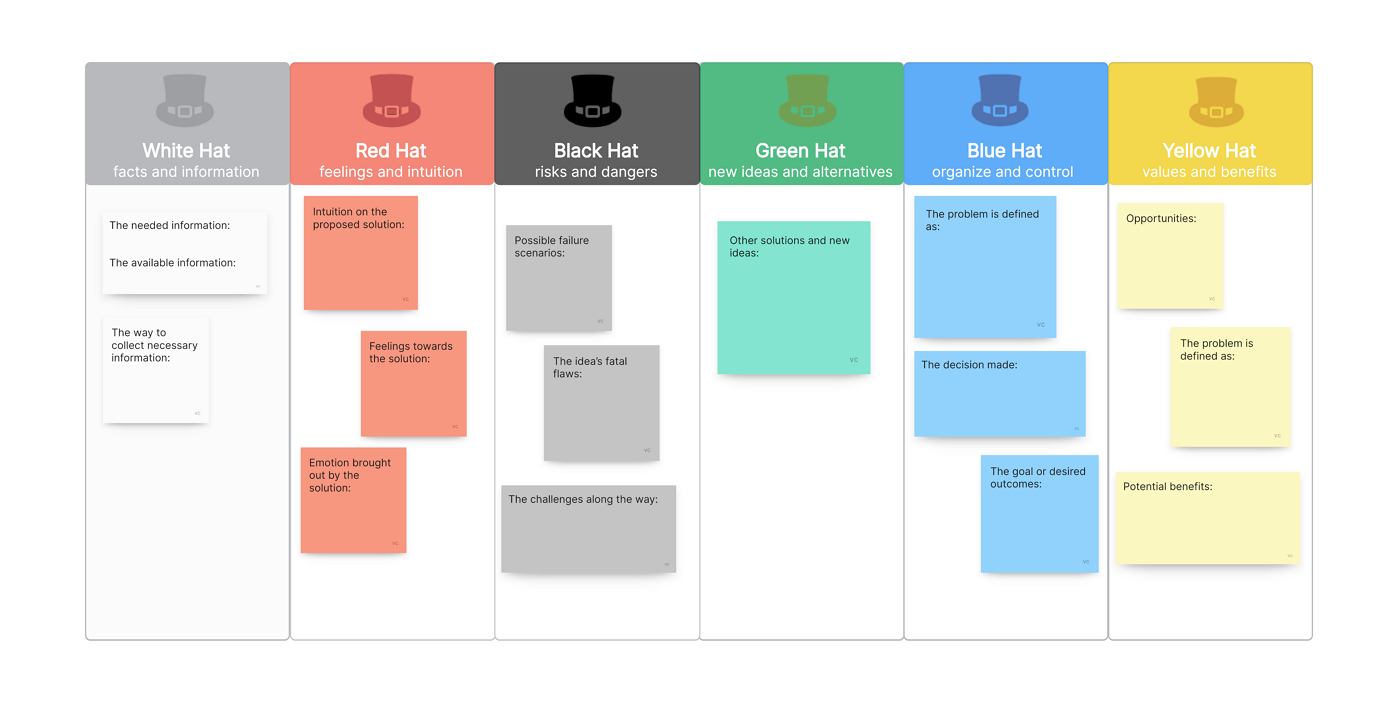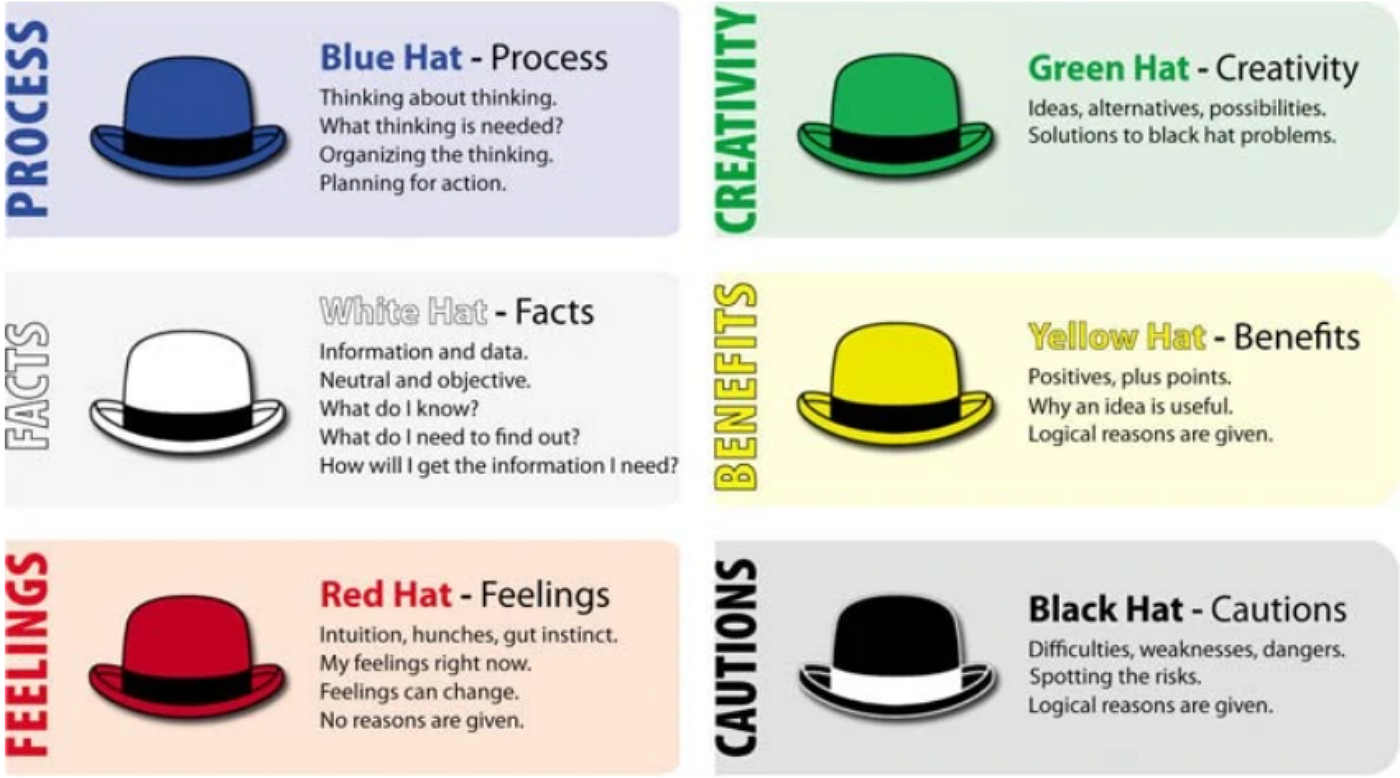What are the Six Thinking Hats?
The six thinking hats is a style of thinking that was first coined by Dr. Edward de Bono. The theory was designed to help users visualize putting on different hats to represent different perspectives or ways to approach a problem. Each hat references a different style of thinking or aspect to consider. The six hats within the six thinking hats template are:
- White Hat:
The white hat is focused on objective data and information. It encourages the user to simply seek out facts regarding a situation, and identify any holes in their knowledge.
- Red Hat:
The red hat is focused on the feelings and intuition of the user/problem solver. This is about identifying gut feelings or emotions regarding a situation. Within this aspect of the six thinking hats template, the user does not necessarily have to be logical or justify their feelings, they just need to identify them.
- Black Hat:
The black hat relates to critical thinking. Within this perspective of this template, users are encouraged to take a step back and identify any potential risks, weaknesses, or hazards within their situation. Users are encouraged to think using alternative perspectives to identify how others might feel, and get a wider understanding of the situation even if they don't agree or think the outcomes are realistic.
- Yellow Hat:
Within the six thinking hats example, the yellow hat stands for positive thinking. This is the opposite perspective of the black hat. This perspective encourages users to think about all of the positive aspects of a situation, and all of the benefits and opportunities that may come from it.
- Green Hat:
The green hat stands for creative thinking. It pushes the users to think about ideas and alternative outcomes for a situation. This is designed to encourage developing new perspectives for a situation or problem, and see them and their solutions from different angles. While not all perspectives may be likely or possible, it helps to open up the potential for different outcomes.
- Blue Hat:
The final hat in the six thinking hats template is the blue hat. This is about the process of thinking itself, and is also known as the “control” hat. This aspect of thinking is about the thinking process itself, and how users can keep thoughts organized and on track. This ensures that while trying to solve a problem, users work towards this end result instead of creating more unanswered questions.
Best Practices for Using Six Thinking Hats
This template is a loose guideline that encourages a broad way of thinking. It’s general enough that it can be applied however the user sees fit, according to the situation, but there are some best practice guidelines to help ensure it is as productive as possible.
Firstly, the problem that you are addressing with the six thinking hats template needs to be identified and defined. Once you know exactly what you are supposed to be thinking about, it helps to keep everything on track. This template also needs to be understood, so that it is being used in a way that will help to create useful outcomes.
Once the problem and this template are understood, the template needs to be evaluated for usefulness within that specific situation. Although the six thinking hats template can be useful, this is only when users are trying to holistically understand a problem and come to a solution. Users should remain focused on the different styles of thinking differentiated by each hat, and ask broad questions to help generate helpful ideas and information. Questions should be open-ended and they should facilitate the different types of deep thinking that are intended.
Users of this template should remember to be flexible. The point of the template is to encourage different styles of thought, not just one or two. Users should aim to utilize all hats, as well as consider the different ways that each hat is interconnected, and how others might contradict each other.
Examples of using Six Thinking Hats in different scenarios:
Here are some general six thinking hats examples, so it’s easier to understand how the framework can be applied in real life, and to what kind of scenarios.
Problem Solving: A restaurant team is facing a problem caused by multiple complaints. Using the white hat, creators can gather details about what the problem itself is, and what the results generated by this problem are. They can then utilize the red hat to acknowledge all the issues and frustrations caused by the problem itself. The black hat perspective will help the restaurant team to predict all potential risks with the existing problem and potential solutions, while the yellow hat identifies all the positives and potential solutions. The green hat will think of creative solutions, and the blue hat will focus on the problem-solving journey itself to keep it on track.

Decision Making: If a company needs to make a significant business decision, they can apply the six thinking hats template to guide them. This helps to analyze the situation (especially with the black and yellow hats), as well as work through all the potential solutions and how they might negatively or positively impact the company.

Brainstorming: Brainstorming sessions are designed to encourage creativity and unique ideas and solutions, so this template can help to ensure these ideas are facilitated while remaining on topic. Specifically, the green hat can foster creative ideas and thoughts, while the blue hat will help to keep everything aligned with a potential solution or answer.

Strategic Planning: The six thinking hats example will help with strategic planning in many ways. It will help to analyze the situation that requires planning, understand all potential future actions (as well as their pros and cons), to hopefully come up with a creative solution and path forward.
https://www.smestrategy.net/blog/using-the-6-thinking-for-strategic-planning
Innovation: Companies are always looking for new ways to grow and develop, and the six thinking hats example is the perfect method to try and foster creativity for tangible results. Focusing on the green hat, users can come up with fresh ideas that may be unconventional, then use the black and yellow hats to weigh options against reality and the likelihood of success.
https://innovationcloud.com/blog/six-thinking-hats-as-idea-generation-method.html
Pros and Cons of the Six Thinking Hats Methodology
There are many advantages to utilizing the six thinking hats framework, as it’s comprehensive and helps to identify multiple perspectives. This holistic approach to any situation helps to ensure that ideas are well thought-out, and that the best solution is selected. Generally, most people will naturally favor one or two hats in terms of the way that they think. By encouraging group discussions and sharing of thoughts, people can contribute more meaningfully, and contribute to a system that requires participation from all. Finally, it generates opportunities for creativity, which in turn can increase the facilitation of innovation and creative, unique solutions.
While the six thinking hats example is a useful framework, it is not perfect for every scenario. There may be some situations that do require a very nice way of thinking, and not necessarily a broad range of different perspectives. Although this framework is designed to be broad, it is not necessarily deep, creating only surface-level thoughts and ideas.










